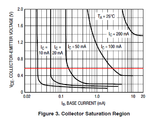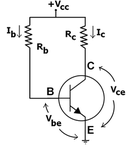p11
Banned
we know if base current increases , collector current should decrease as IE=IB+IC,... again , if base current increases , collector current should increase ,as ic=Bib...plz help... i got confused suddenly....
Follow along with the video below to see how to install our site as a web app on your home screen.
Note: This feature may not be available in some browsers.
in an usual transistor circuit this is not true.we know if base current increases , collector current should decrease
Let´s start the experiment and say: IB = 1mA, IC = 50mA, then IE = 51mA
Now we increase IB to 2mA, then we expect IC to become about 100mA and thus IE becomes about 102mA.
Hi,
Please don't leave us in igorance.
Klaus
please explain me physically , i am not getting ... i dont want too know mathematically...
Do you know how a pn diode works?
Do you know that (and why) the thickness of the pn-region depends on the externally applied voltage?
In principle, we have the same effect (working principle) for transistors.
..... hence as ib increases , ic should increase .....
the majority of the charged carriers go NOT to the base but are crossing the pn region and, then, are attracted by the collector (which has a greater potential than the base node).

Certainly, there is a base current and in most cases we consider it (Ib=Ic/beta) during resistor calculations. But it has no control function at all.
It simply does exist - as a kind of by-product - because only 95...99% of the charged carriers reach the collector (and the rest goes to the base forming the base current).

Hi,
I´m really surprised by your explanation.
I wonder why you take your focus on collector current ... and the same time it seems you ignor that all the collector current goes through emmitter, too.
So I´d say: If the base (current) influences collector current, then it also influences emitter current. --> the collector current can not flow in a single point.
Klaus
For me something in your explanation does not fit to the folowing chart (which is from the Fairchild BC546 datasheet).
View attachment 133491
I draw the red line. It is the expected V_BE when the BJT is in its usual operating point.
Now let´s focus on the area below the red line.
It is the area where the potential of the base is lower than the potential of the collector.
Maybe a misunderstanding: Do you really say the collector current controls the base current?
This view is too simplified. What really happens is the following:two scenariosstart with bjt biased in a way that VCE = VCC/2)
1) change Rb to change IB --> I´d say this has the effect that IC changes, too. (according b at this operating point)
Why do you think that a change in Rc would change Ic? This is not the case! (neglecting minor effects).2) change Rc to change IC --> I´d say this has about no effect on IB. (far away from b)
Voltage, current, and charge control
The collector–emitter current can be viewed as being controlled by the base–emitter current (current control), or by the base–emitter voltage (voltage control). These views are related by the current–voltage relation of the base–emitter junction, which is just the usual exponential current–voltage curve of a p-n junction (diode).[2]
Hi,
I must say I'm confused, because your explatation sometimes says the opposite of what I've learned.
Hi,
I really can't follow your explanations. About potential...why 0.4V is more potential than 0.6V for example...maybe you don't talk about voltage potential...
Hi,
Why you talk abot Rbe as an ohmic resistor in a voltage divider configuration. In my eyes Vbe is rather constant than it varies with base current.
Wikipedia says:
.........
........
Maybe there is more than one explanation.
Maybe your explanation is more correct in terms of the true physical behaviour. I really don't know.
But in this forum it assume it more confuses than it helps - especially the newbies and hobbyists (and at least me)
Hi,
Don't start a personal fight.
It's the OP's thread.
Klaus